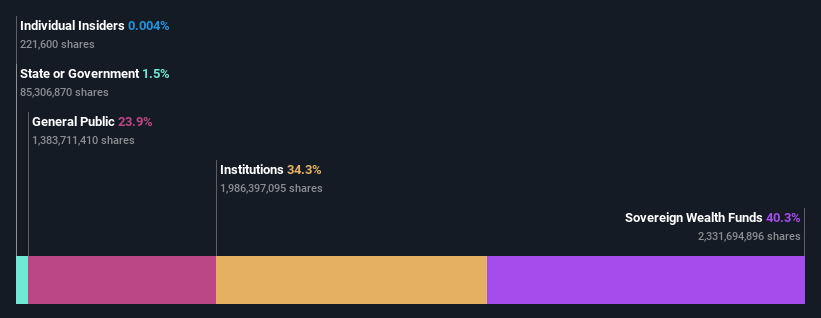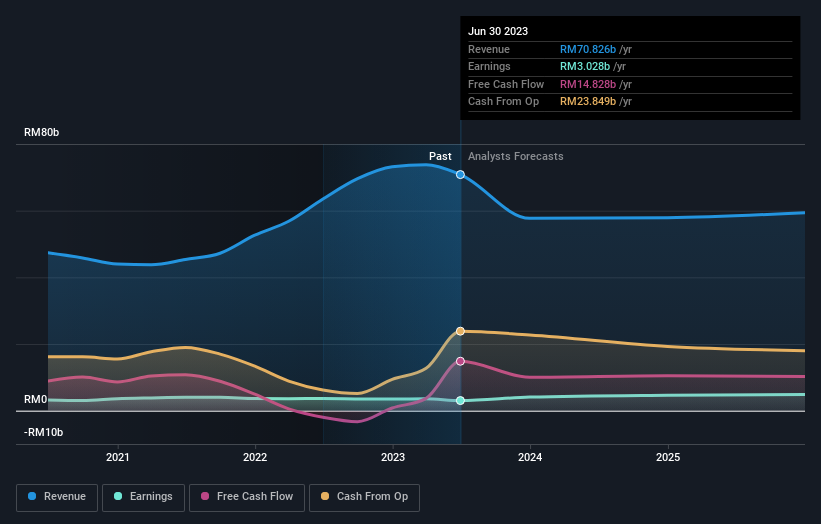Tenaga Nasional Berhad (KLSE:TENAGA) most popular amongst sovereign wealth funds who own 40% of the shares, institutions hold 34%
Key Insights
Significant control over Tenaga Nasional Berhad by sovereign wealth funds implies that the general public has more power to influence management and governance-related decisions
56% of the business is held by the top 3 shareholders
A look at the shareholders of Tenaga Nasional Berhad (KLSE:TENAGA) can tell us which group is most powerful. The group holding the most number of shares in the company, around 40% to be precise, is sovereign wealth funds. Put another way, the group faces the maximum upside potential (or downside risk).
Institutions, on the other hand, account for 34% of the company's stockholders. Institutions will often hold stock in bigger companies, and we expect to see insiders owning a noticeable percentage of the smaller ones.
Let's delve deeper into each type of owner of Tenaga Nasional Berhad, beginning with the chart below.
View our latest analysis for Tenaga Nasional Berhad
What Does The Institutional Ownership Tell Us About Tenaga Nasional Berhad?
Many institutions measure their performance against an index that approximates the local market. So they usually pay more attention to companies that are included in major indices.
As you can see, institutional investors have a fair amount of stake in Tenaga Nasional Berhad. This implies the analysts working for those institutions have looked at the stock and they like it. But just like anyone else, they could be wrong. If multiple institutions change their view on a stock at the same time, you could see the share price drop fast. It's therefore worth looking at Tenaga Nasional Berhad's earnings history below. Of course, the future is what really matters.
Tenaga Nasional Berhad is not owned by hedge funds. Khazanah Nasional Berhad is currently the largest shareholder, with 23% of shares outstanding. Meanwhile, the second and third largest shareholders, hold 18% and 16%, of the shares outstanding, respectively.
A more detailed study of the shareholder registry showed us that 3 of the top shareholders have a considerable amount of ownership in the company, via their 56% stake.
Researching institutional ownership is a good way to gauge and filter a stock's expected performance. The same can be achieved by studying analyst sentiments. There are plenty of analysts covering the stock, so it might be worth seeing what they are forecasting, too.
Insider Ownership Of Tenaga Nasional Berhad
While the precise definition of an insider can be subjective, almost everyone considers board members to be insiders. Company management run the business, but the CEO will answer to the board, even if he or she is a member of it.
Most consider insider ownership a positive because it can indicate the board is well aligned with other shareholders. However, on some occasions too much power is concentrated within this group.
Our information suggests that Tenaga Nasional Berhad insiders own under 1% of the company. As it is a large company, we'd only expect insiders to own a small percentage of it. But it's worth noting that they own RM2.2m worth of shares. It is good to see board members owning shares, but it might be worth checking if those insiders have been buying.
General Public Ownership
With a 24% ownership, the general public, mostly comprising of individual investors, have some degree of sway over Tenaga Nasional Berhad. While this size of ownership may not be enough to sway a policy decision in their favour, they can still make a collective impact on company policies.
Next Steps:
While it is well worth considering the different groups that own a company, there are other factors that are even more important. Like risks, for instance. Every company has them, and we've spotted 2 warning signs for Tenaga Nasional Berhad (of which 1 makes us a bit uncomfortable!) you should know about.
Ultimately the future is most important. You can access this free report on analyst forecasts for the company.
NB: Figures in this article are calculated using data from the last twelve months, which refer to the 12-month period ending on the last date of the month the financial statement is dated. This may not be consistent with full year annual report figures.
Have feedback on this article? Concerned about the content? Get in touch with us directly. Alternatively, email editorial-team (at) simplywallst.com.
This article by Simply Wall St is general in nature. We provide commentary based on historical data and analyst forecasts only using an unbiased methodology and our articles are not intended to be financial advice. It does not constitute a recommendation to buy or sell any stock, and does not take account of your objectives, or your financial situation. We aim to bring you long-term focused analysis driven by fundamental data. Note that our analysis may not factor in the latest price-sensitive company announcements or qualitative material. Simply Wall St has no position in any stocks mentioned.


